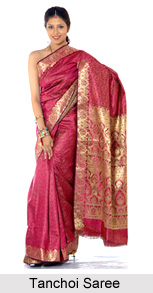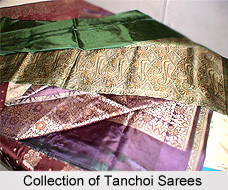 Tanchoi Sarees are the traditional sarees of Surat. The weavers of Gujarat are known for weaving this unique variation of silk sarees in India. The Tanchoi Sarees of India are the most sought after items for the Indian women. These sarees are available in vibrant colours and the artisans add an extra sheen to the sarees to give them a metallic look and suit the ceremonial purpose. The exquisite heavy silk, intricate thread work used on these sarees, the subtle colours and the rich fabric make the Tanchoi sarees a hot favourite among women, not only from Gujarat, but other parts of the country.
Tanchoi Sarees are the traditional sarees of Surat. The weavers of Gujarat are known for weaving this unique variation of silk sarees in India. The Tanchoi Sarees of India are the most sought after items for the Indian women. These sarees are available in vibrant colours and the artisans add an extra sheen to the sarees to give them a metallic look and suit the ceremonial purpose. The exquisite heavy silk, intricate thread work used on these sarees, the subtle colours and the rich fabric make the Tanchoi sarees a hot favourite among women, not only from Gujarat, but other parts of the country.
Though the silk used for Tanchoi Sarees are quite heavy and rich, the colours used are mostly sober and subtle, making it an excellent combination. These sarees are embodiments of richness and elegance as the weaving of these sarees makes use of many threads made of silk. The sarees are finally created after going through several refinement processes. Tanchoi sarees are also admired as the wedding sarees in different regions in India. This particular Tanchoi sarees that are used as wedding sarees, are generally heavy silks that are also worn in other festivals and occasions. Tanchoi sarees of Gujarat mostly have a satin finish.
Origin of Tanchoi Sarees
As per the history of Tanchoi sarees, the Tanchoi brocades are originated from China. This type of saree was introduced in India by the ongoing trade between Parsi, China and England and India in 19th century. It is believed that in the last half of the 19th Century, 3 Parsi brothers called "Chhoi" learned the technique of weaving these brocades in China and introduced it to Indian weavers in Surat at Gujarat. Hence the name Tanchoi, which literally means "Three Chhois" was given to this particular sarees. A descendant of one of these brothers continued producing Tanchoi sarees in Bombay into the early 1950s.
Present Day Scenario of Tanchoi Sarees
Although Tanchoi textiles are traditionally "Amru Brocades" that originated in China, Benaras took over the market in the 1940s and 1950s, and began to incorporate zari. After the introduction of Tanchoi sarees, the Varanasi weavers started making less expensive versions. Banarasi weavers started incorporating zari work into Tanchoi sarees. Banarasi Tanchoi sarees have evolved in different varieties over the decades. Since then the amalgamation of Chinese technique with Indian style of weaving was created to form the Indianised version of Tanchoi sarees.
Making of Tanchoi Sarees
 Tanchoi Saree is weaved in a figured silk and is technically related to complex weaves because it has 1 or 2 warp and 2 to 5 weft colours often in the same shed on Silk fabric. A densely patterned, heavy fabric is created without any floats on the reverse. Sometimes, the `unused` threads are woven into the `foundation` at the back. As per the tradition of creating these sarees, the weavers create the face of the fabric with a satin weave ground (warp threads) with small patterns made by the weft threads repeated over the entire surface.
Tanchoi Saree is weaved in a figured silk and is technically related to complex weaves because it has 1 or 2 warp and 2 to 5 weft colours often in the same shed on Silk fabric. A densely patterned, heavy fabric is created without any floats on the reverse. Sometimes, the `unused` threads are woven into the `foundation` at the back. As per the tradition of creating these sarees, the weavers create the face of the fabric with a satin weave ground (warp threads) with small patterns made by the weft threads repeated over the entire surface.
Designs of Tanchoi Sarees
Famed for the intricate and small weaving patterns over the fabric, the commonly used patterns used are those of flowers, small birds in flight, peacocks and parrot motifs. In fact Tanchoi sarees are one of a kind which have spots all over the surface and are woven with a dual color wrap. Another stand alone feature of the Tanchoi sarees is that the fabric texture background has a Satin finish. Some extra threads are added to give the saris an appearance of being embroidered.
Varieties of Tanchoi Sarees
Tanchoi Sarees has several differen varieties:
•Satin Tanchoi - As the name suggests, it is based on a Satin fabric base of a single colour and the weft threads of one or more colours.
•Satin Zari Tanchoi - This is an extension of Satin Tanchoi wherein the weft is a combination of either one Silk and one Gold thread or two Silk threads and one Gold thread.
•Atlas or Gilt - The fabric surface is pure satin. In comparison to other fabrics, Atlas or Gilt is heavier and has more shine because of the extra use of zari.
•Mushabbar - This version stands out with its net woven design to appear as bushes or branches of a tree. The Mushabbar design is often associated with a jungle or nature"s greenery.





















